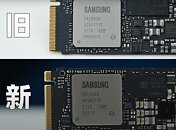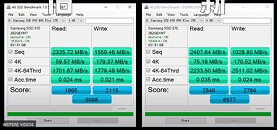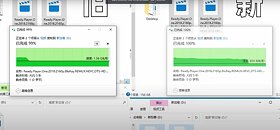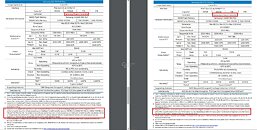Raevenlord
News Editor
- Joined
- Aug 12, 2016
- Messages
- 3,755 (1.19/day)
- Location
- Portugal
| System Name | The Ryzening |
|---|---|
| Processor | AMD Ryzen 9 5900X |
| Motherboard | MSI X570 MAG TOMAHAWK |
| Cooling | Lian Li Galahad 360mm AIO |
| Memory | 32 GB G.Skill Trident Z F4-3733 (4x 8 GB) |
| Video Card(s) | Gigabyte RTX 3070 Ti |
| Storage | Boot: Transcend MTE220S 2TB, Kintson A2000 1TB, Seagate Firewolf Pro 14 TB |
| Display(s) | Acer Nitro VG270UP (1440p 144 Hz IPS) |
| Case | Lian Li O11DX Dynamic White |
| Audio Device(s) | iFi Audio Zen DAC |
| Power Supply | Seasonic Focus+ 750 W |
| Mouse | Cooler Master Masterkeys Lite L |
| Keyboard | Cooler Master Masterkeys Lite L |
| Software | Windows 10 x64 |
A number of manufacturers have been caught red-handed, so to speak, by changing components on their SSD products without as much as a product specifications change. This has happened in the past with ADATA, Patriot, and more recently with Western Digital and its WD Blue SN550; now, it's Samsung that's being on the receiving end of a more attentive look at their recent batches of the 970 EVO SSD - particularly its 1 TB configuration.
According to Computerbase, a YouTube channel in Asia seems to have first noticed the difference. They've tested the older version of Samsung's 970 Evo Plus 1 TB (product number MZVLB1T0HBLR, April 2021 production date, a Phoenix controller [S4LR020] and 96-layer 3D TLC NAND) against the newer (product number MZVL21T0HBLU and is equipped with an Elpis controller [S4LV003] and 3D-NAND with the identifier K9DUGY8J5B-CCK0), which likely features different packaging and density for the same 96-layer 3D TLC NAND.




It seems that the new version of the SSD is faster in workloads up to 115 GB - the size of its revised SLC cache, meant to absorb burst of write activity at faster speeds than the remainder NAND working in TLC mode. The original SLC cache provision stood at 42 GB, which is what the original version shipped with, and whose behavior is confirmed in testing - the original release of the Samsung 970 Evo Plus exhausts its SLC cache (with the appropriate performance drop from overflowing into TLC) at around 40 GB. This performance change is a welcome one, even if it too should be updated on the drives' official specifications. The drive does however deliver lower performance once its SLC cache is exhausted - the original version kept chugging along with data writing speeds of around 1,500 MB/s after the first 40 GB were written, while the new revision drops that performance to 800 MB/s after 115 GB of writes. So users can be faced with either improved performance, or worsened performance, in this same product compared to the original. Check the results in the gallery below, where the original revision is on the left side (BIOS 2B2QEXM7), and the new revision is on the right (3B2QEXM7).








Component changes in electronics are not uncommon themselves; there are a number of products and chips that can employ several alternatives in the supply chain. this has become especially more important a safety mechanism for manufacturers with the still straining electronics supply chains, which are still reeling from Covid-19. However, sometimes changes are enacted not because manufacturers are forced to do it on account of component shortages; sometimes, they do it to save some extra dollars here and there. The problem arises when a products' performance characteristics suffers from the component change, which has been the case, every single time, for these changes in SSD components. The Samsung case is a different one - there are specific performance improvement and degradation according to workload.
Samsung differs in its peers by actually introducing a new serial number - as well as a new BIOS version - for this particular 970 EVO Plus rendition. However, would it be so hard to do this the right way again? Samsung had already done it with their 850 EVO V2 - which clearly demonstrated that two different revisions were available for the same product, with differing specifications listings as well. this is the way to not confuse customers. However, maybe Samsung felt they had no good way of doing this change: the drive isn't clearly better or clearly worse than the original revision it replaces. That said, slightly more information - or a press release from Samsung - could have mitigated these issues. Users should be able to know exactly what their money is purchasing. Check the original video below.
View at TechPowerUp Main Site
According to Computerbase, a YouTube channel in Asia seems to have first noticed the difference. They've tested the older version of Samsung's 970 Evo Plus 1 TB (product number MZVLB1T0HBLR, April 2021 production date, a Phoenix controller [S4LR020] and 96-layer 3D TLC NAND) against the newer (product number MZVL21T0HBLU and is equipped with an Elpis controller [S4LV003] and 3D-NAND with the identifier K9DUGY8J5B-CCK0), which likely features different packaging and density for the same 96-layer 3D TLC NAND.




It seems that the new version of the SSD is faster in workloads up to 115 GB - the size of its revised SLC cache, meant to absorb burst of write activity at faster speeds than the remainder NAND working in TLC mode. The original SLC cache provision stood at 42 GB, which is what the original version shipped with, and whose behavior is confirmed in testing - the original release of the Samsung 970 Evo Plus exhausts its SLC cache (with the appropriate performance drop from overflowing into TLC) at around 40 GB. This performance change is a welcome one, even if it too should be updated on the drives' official specifications. The drive does however deliver lower performance once its SLC cache is exhausted - the original version kept chugging along with data writing speeds of around 1,500 MB/s after the first 40 GB were written, while the new revision drops that performance to 800 MB/s after 115 GB of writes. So users can be faced with either improved performance, or worsened performance, in this same product compared to the original. Check the results in the gallery below, where the original revision is on the left side (BIOS 2B2QEXM7), and the new revision is on the right (3B2QEXM7).








Component changes in electronics are not uncommon themselves; there are a number of products and chips that can employ several alternatives in the supply chain. this has become especially more important a safety mechanism for manufacturers with the still straining electronics supply chains, which are still reeling from Covid-19. However, sometimes changes are enacted not because manufacturers are forced to do it on account of component shortages; sometimes, they do it to save some extra dollars here and there. The problem arises when a products' performance characteristics suffers from the component change, which has been the case, every single time, for these changes in SSD components. The Samsung case is a different one - there are specific performance improvement and degradation according to workload.
Samsung differs in its peers by actually introducing a new serial number - as well as a new BIOS version - for this particular 970 EVO Plus rendition. However, would it be so hard to do this the right way again? Samsung had already done it with their 850 EVO V2 - which clearly demonstrated that two different revisions were available for the same product, with differing specifications listings as well. this is the way to not confuse customers. However, maybe Samsung felt they had no good way of doing this change: the drive isn't clearly better or clearly worse than the original revision it replaces. That said, slightly more information - or a press release from Samsung - could have mitigated these issues. Users should be able to know exactly what their money is purchasing. Check the original video below.
View at TechPowerUp Main Site






